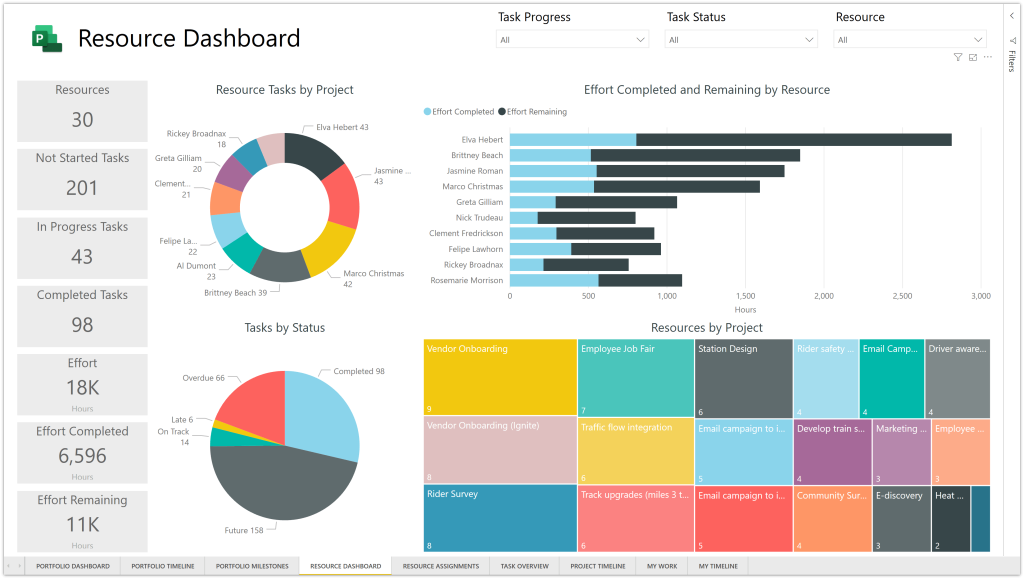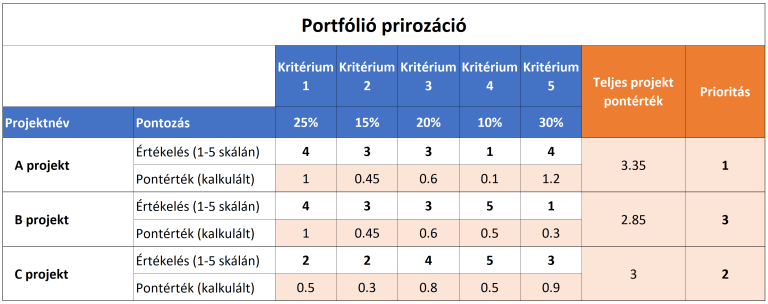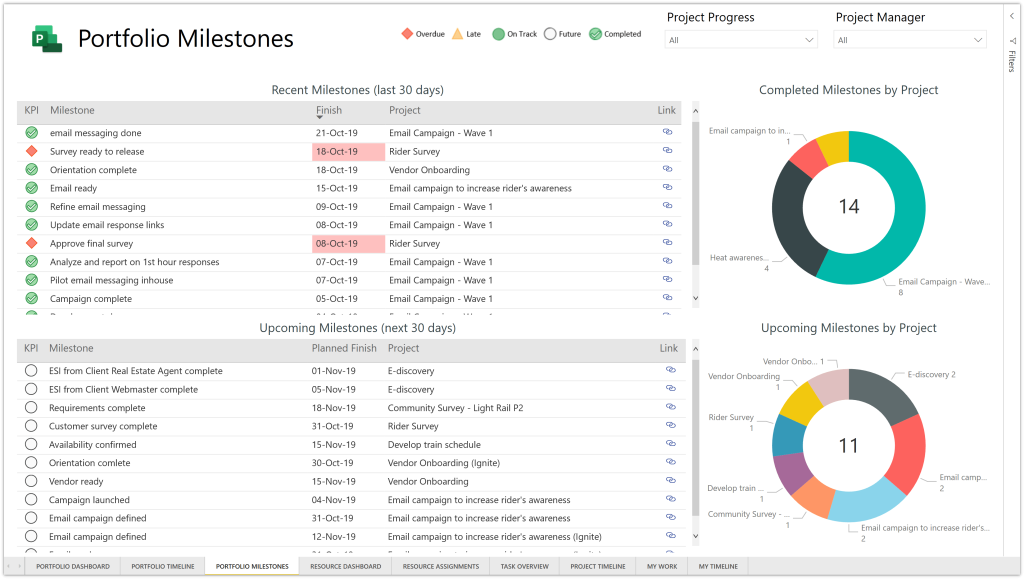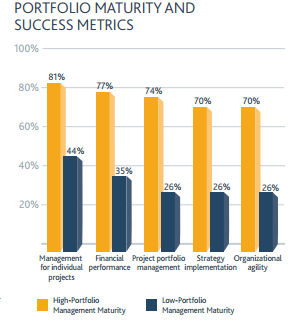Written by: Domonkos Végh, PMP, PMI-ATP trainer
Project portfolio management crash course
Project portfolio management (PPM) focuses on selecting the right projects and getting them off the ground at the right time, and is therefore fundamentally different from project management practice, which focuses on getting them right. The subject of project portfolios is often a more difficult and complex issue than project methodology development, but it represents an important organisational development focus for conscious planning organisations. In our blog post, we explore how project portfolios can be managed effectively and explore the benefits - but also the pitfalls - that can be associated with them.
Table of contents
Introduction
We hear these questions and comments a lot during our counselling and training work:
- "What is a project portfolio?"
- "What is project portfolio management?"
- "We certainly don't have that..."
- "We have never heard of such a thing, we don't even have clear strategic directions, although..."
As many organisations are also struggling to improve their project management methodology, there is often not enough momentum and commitment left to deal with the project portfolio, even though the right portfolio process can bring significant improvements and capacity release at project level. It is not enough to do projects well, the organisation needs to work on good projects.
No organisation has more project ideas than spare capacity and resources. Very often, for example, management finds it difficult to say no to a love project, so they rush to squeeze them into the calendars of already overburdened project teams. Despite the organisation investing large amounts of man-hours and capital in projects, the results are mediocre, colleagues complain of a heavy workload and the smiles of customers don't seem genuine at handover. The above example is a perfect recipe for our colleagues to work on the wrong projects and/or too many projects, while success closure is at a minimum doubtful and results are sub-optimal.

Project portfolio management tasks start with the selection of the right projects, but also include their ongoing management and coordination, and often the measurement of their success after closure. We can also think of project portfolios as organised investment portfolios, as organisations typically embark on a project to create business value for themselves. Thus project management and portfolio management require quite different techniques and perspectives, yet they are closely related.
Good PPM procedures align projects with the strategic direction and annual objectives of the organisation, help to use limited resources and help to manage synergies and overlaps between projects effectively.
Preparing the project portfolio
What are the objectives of project portfolio management?
By definition, project portfolio management is therefore the totality of all the projects in an organisation and the process by which the projects undertaken by the organisation are aligned to meet organisational objectives and thereby increase the value or business results of the organisation. PPM has several objectives:
- Primary objective- to achieve coherence and alignment between the projects carried out by the organisation and the organisational objectives and strategy.
- Secondary objective- to determine the costs and expected return on the projects undertaken by the organisation in order to identify the best project investment opportunities.
- Third objective- to help the organisation make good use of the resources available.
- Fourth objective- it aims to make the status of each project and its results transparent.
- Finally, a fifth objective is to enable the organisation to respond to changes at portfolio/strategic level over time.
The PPM process
The project portfolio management process consists of several sequential steps. The process starts with an examination of the organisation's strategic objectives in the short, medium and long term, as one of the most important tasks of PPM is the development of a project portfolio linked to the strategic objectives. A project portfolio aligned to business objectives ensures that resources are used efficiently and that projects contribute to the achievement of business objectives. In the extreme case where the organisation does not have a clear strategy, the portfolio managers' task may even start with defining the organisational strategy.
It is important to note here that this process is a constant activity, as the organisation's goals and strategies may change, so it may be necessary to re-evaluate projects and redesign the portfolio. Also at the extreme, but in the case of major strategic shifts, it may be necessary to rebuild the entire project portfolio. In addition, the process of project portfolio management often requires senior management decisions, as the selection and alignment of projects can often have a major impact on the functioning and success of the organisation.
So the first step is to identify the key organisational strategic objectives against which the project selection will be made - defining the primary basis for building our portfolio. This can be annual, quarterly, even monthly in extremely volatile business environments.
In the second step, projects and ideas to be implemented by the organisation are identified, filtered and categorised. Ongoing projects should also be evaluated for their fit with the strategic directions. If a project no longer supports the new strategy, it will often fall victim to premature abandonment. The fact that a project idea is maximally aligned with the strategic directions of the organisation does not necessarily mean that it will be included in the final portfolio, as at this point the resource constraints of the organisation also need to be taken into account, such as capacity and competence constraints of human resources, time constraints and funding opportunities.
In a third step, the filtered but not yet final portfolio of candidate items is prioritised. By taking these priorities into account, organisations can decide which projects will actually start - i.e. which will be included in the project portfolio - which will be rejected, which will be scheduled for later, and which of the projects that may be running will be permanently stopped.
When prioritising, organisations can also take into account the expected outcomes of projects (both quantifiable and non-quantifiable elements can be considered), the level of risk of projects, feasibility and difficulty of implementation, availability of resources and timeframes, and the linkages and overlaps with other elements in the project portfolio.
Brief overview of portfolio prioritisation methodologies
Our clients and training participants who are learning about project portfolio management are most often curious about the project prioritisation process, and they always have many questions about the related methodologies. Prioritising projects within the project portfolio therefore means determining the relative importance of projects among the projects carried out by the organisation. The aim of prioritisation is to identify the most important projects that will help the organisation to achieve its objectives and put it in a more advantageous position.
There are several ways to prioritise projects, one of which is the weighting method, whereby organisations identify a number of criteria, typically 5-15, for evaluating projects. These criteria are then weighted with decision-makers, typically using an anonymous questionnaire method. They then rate each project on a scale of the identified and weighted criteria, resulting in a priority order.

The advantage of the weighting method is that it is relatively easy to use, it is quick, it identifies a clear order among projects, it can directly assess the closeness of the project to the strategic objectives. The disadvantage is that the weighting method does not necessarily take qualitative factors into account and it can be difficult to determine weights.
Another option is the criteria-based method, which assesses how well a project meets pre-defined criteria on a yes-no scale. The advantage of the criteria-based method is that it is simple, quick and the criteria system is flexible. The disadvantage is that it does not take quantitative factors into account, the flexibility of interpretation can cause communication problems, it is too simple in places and can produce an ambiguous result.

Other easier, more flexible methods for prioritising projects are also available, such as priority matrices. The Monopoly money "project fair" and the MoSCoW technique can also be useful tools, which are mainly used in project management, but can also be effective in prioritising projects at portfolio level. In the Monopoly money method, each participant is given a set amount of play money, which they can then use to put any amount of money they like next to their project ideas - symbolising how much they think the project is "worth". After everyone has spent their money, the play money is added up to form the order of the portfolio.

Finally, one last option for voting methodwhere projects are prioritised by a decision-making committee or department. The advantage of the voting method is that it is preceded by a discussion and does not require much technical preparation. The disadvantage is that it is difficult to determine the preferences of the voters, is time-consuming to use and often leads to compromise situations, which are rarely ideal for business value creation.
In summary, each method has its advantages and disadvantages, and the most appropriate method for the organisation should be chosen based on the project context and the strategic objectives of the organisation. It is important to note that prioritisation of projects within a project portfolio is also an ongoing activity, as indicated above, the strategic direction of the organisation may change over time.
Maintaining the project portfolio
Once the portfolio is populated with the right projects, the next task is to monitor and maintain the ongoing projects. At this point, management oversight is provided by sponsors appointed alongside PPM specialists, and it is common that the responsibilities of the two roles (sponsor and portfolio manager) are not precisely separated. Post-assembly tasks:
- Project portfolio analysis and evaluation: Projects that have reached implementation status are not exempt from the PPB's attention, whether they continue to meet the criteria validated at selection is a matter to be continuously monitored, so projects in the project portfolio are frequently analysed and evaluated, especially in the light of new information that emerges as they progress (e.g. new risks, overlaps with other projects not previously known, changes in the environment, etc.). This takes into account the project's priority, risks, resources required and duration. The results of the assessment will be used to decide on the fate of the projects in the portfolio.
- Coordination of projects: Basic coordination between projects in the project portfolio is sometimes necessary. For example, where certain projects overlap, there may be a case for grouping them into a single programme (in effect a "mega-project"), as they can often support similar objectives. The disruption of one project can have spill-over effects on other projects, often causing resource constraints and generating new risks for other initiatives. Coordination must therefore take into account the impact of each project on the implementation of other projects and on the organisation as a whole.
- Monitoring and supervision of projects: As anticipated in the previous section, the progress and effectiveness of projects in the project portfolio are constantly monitored and tracked by experts. This involves monitoring project budgets, deadlines, milestones met or missed and results, and intervening in project management where necessary. When a project is no longer realistic to deliver the defined business value, may no longer be profitable or may no longer serve the organisational strategy, all may be good reasons to stop it before completion. Unfortunately, it is a common bad practice that even in such clear-cut cases, projects that have been 'long running' are terminated by the organisation on the grounds of honour alone. This is clearly a less than ideal use of organisational resources and should be avoided.
- Facilitating communication: Another possible task of project portfolio management is to ensure effective communication between the projects and stakeholders in the project portfolio. This is to ensure effective sharing of resources and information, as well as understanding and acceptance of common goals and strategies.

Organisational benefits of project portfolio management
We have already mentioned a number of organisational benefits in this post, but it is perhaps worth listing them all together. The most important, general organisational advantages include the following:
- Alignment of objectives: Identifying and defining business and strategic objectives, then aligning projects with these objectives and contributing to their achievement.
- Efficient use of resources: Make more efficient use of time, financial resources and manpower through prioritisation and portfolio management of projects, providing easier management and control.
- Reducing the risks: Reducing the risk of projects through project portfolio management, which helps the organisation identify the projects that will deliver the best results and avoid undesirable projects.
- Better decision making: Decision-makers have a clearer view of the project portfolio and are better able to decide on project priorities and resource allocation.
- Greater transparency on project success: There are a number of ways to measure the success of closed projects, and portfolio managers can define follow-up steps and actions to determine these when an item is removed from the portfolio. The benefits of back-testing include, of course, the ability for organisations to understand which projects have been successful and which have not, and why. Such assessments can also help organisations to improve project management processes and plan for future projects.
- Improved project management maturity and approach: With the right pre-screening and prioritisation, fewer but important projects can be managed with greater care and therefore expertise, improving the quality of results at project and organisational level.
- Sharing feedback and experiences: Sharing project management experience and best practices with all project teams, enabling the organisation to improve results and implement further projects more effectively.
Potential organisational drawbacks of project portfolio management
In addition to the benefits, there are of course elements that make it okay to approach the topic of project portfolio management with some caution. There are also certain disadvantages that should be taken into account:
- Increased costs: implementation and maintenance may involve higher costs due to the necessary technological, training and personnel inputs. While effective PPM does not require the implementation of expensive IT systems at any cost, above a certain organisational size, it is unfortunately not possible to get away with it at low cost. The initial PPM processes and procedures can still be operated with the usual templates and even Microsoft Office products.
- Complexity: the process can be very complex and specific expertise may be needed to apply it effectively.
- Time required: implementation and maintenance may take longer and resources may need to be tied up for longer.
- Slower decision-making: because of the time-consuming nature of the process, decision-making can be slower due to the need to gather and analyse information, and decision-making departments are not flexible enough to meet at any moment.
- Reduced flexibilityprojects have to comply with stricter regulations, which can reduce their flexibility to respond to change. This can also lead to frustration for organisational stakeholders over a period of time, as they realise that they have much less freedom to shape the start-up of individual projects than before.
- Loss of creativity: the regulatory effect can also reduce the creativity and innovation of projects by focusing on strategic objectives and pre-defined guidelines.
- Initial malfunctions: when a project portfolio management system is introduced, the organisation's operations may be temporarily disrupted, as it introduces new processes and rules to the organisation. Therefore, before implementing such a system, it is important to have a thorough understanding of how the organisation works and to prepare the implementation plan taking this into account.
- Change management: the introduction of a project portfolio management system can bring big changes to the way your organisation operates, which you will have to deal with. Some stakeholders always find it difficult to accept and adapt to change. Taking the human factor into account and getting the right actors on board is a challenge, but also critical to success.
Organisational PPM overview and conclusion
Thus, project portfolio management focuses on selecting the right projects and launching them at the right time, while project management focuses on getting them right. Organizations often work on too many projects and the results are sub-optimal, so it is important to take a PPM approach and consider how the process is managed. PPM tasks start with selecting the right projects, including their ongoing management and alignment, and measuring their success after closure can be a related task.

And the main advantage of PPM is that the organisation can work on the right projects that really support the implementation of the strategy, so that they are not just a nice-sounding rhetoric, as in many organisations... This is not just a criticism in piquant terms, there are many statistics to support the claim that the strategy of organisations is not given sufficient operational, or implementation, focus. In recent years, a number of studies have been carried out on the subject, which point to important phenomena:
- EMA's 2018 research showed that only 38% of companies have the tools and systems to manage their project portfolio, but a much higher proportion of these have met their strategic objectives.
- KPMG's 2018 research showed that only 27% of companies have adequate project portfolio management processes and tools in place - far fewer than the EMA research, which was not a particularly strong proportion.
- Also in 2018, PwC's survey found very similar results to KPMG's, showing that only 24% of companies have a transparent project portfolio that allows them to immediately identify organisational priorities and manage resources more effectively.
- According to Forrester's 2019 research, 73% of companies are concerned that their project portfolio is not aligned with their business strategy and cannot deliver a return on investment due to a lack of process and technology.
- Meanwhile, PMI's 2019 survey showed that the implementation of effective project portfolio management for companies has increased overall business results by up to €361TTP3T.
These surveys show that there is still plenty of scope and room for companies to introduce more effective project portfolio management processes and tools.

 Designabc
Designabc